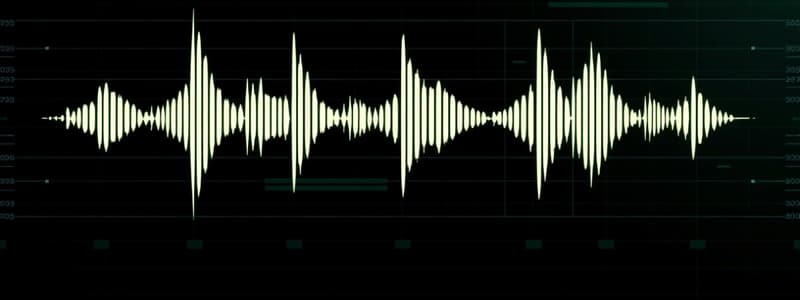Podcast
Questions and Answers
What is a carrier signal?
What is a carrier signal?
A high-frequency signal that carries the information of the message signal.
What does a message signal contain?
What does a message signal contain?
Information to be transmitted, such as voice, music, or data.
What type of modulator directly modulates the carrier by varying its amplitude?
What type of modulator directly modulates the carrier by varying its amplitude?
- Oscillator
- Amplifier
- Standard AM Modulator (correct)
- Balanced Modulator
What does an amplifier do in the context of amplitude modulation?
What does an amplifier do in the context of amplitude modulation?
The carrier frequency must be unstable to ensure consistent signal transmission.
The carrier frequency must be unstable to ensure consistent signal transmission.
Which factor does NOT contribute to signal quality?
Which factor does NOT contribute to signal quality?
The modulation index (m) is defined as the ratio of the amplitude of the modulating signal to the amplitude of the __________.
The modulation index (m) is defined as the ratio of the amplitude of the modulating signal to the amplitude of the __________.
What is the effect of amplitude distortion?
What is the effect of amplitude distortion?
What does multipath distortion cause?
What does multipath distortion cause?
Flashcards are hidden until you start studying
Study Notes
Amplitude Modulation Fundamentals
- Carrier Signal: High-frequency signal that transmits the message signal's information; generated by an oscillator.
- Message Signal: Contains the information to transmit (e.g., voice, music, data) and has a lower frequency than the carrier signal.
- Modulator Types:
- Balanced Modulator: Produces double sidebands (DSB) and may need further processing.
- Standard AM Modulator: Varies the amplitude of the carrier to align with the message signal.
Signal Processing Components
- Amplifier Types:
- RF Amplifier: Boosts radio frequency signal.
- Power Amplifier: Raises signal power for long-distance transmission.
- Antenna: Radiates the modulated signal; must match the carrier frequency for efficiency.
Key Characteristics
- Frequency Stability: Stability of carrier frequency is critical to prevent interference.
- Bandwidth: AM requires bandwidth equal to twice the maximum frequency of the message signal.
- Spectral Efficiency: AM is less efficient in bandwidth usage compared to modern techniques.
- Power Efficiency: AM transmitters have low power efficiency; the carrier carries significant power without information.
Signal Quality and Distortion
- Signal Quality Factors:
- Signal-to-Noise Ratio (SNR): Indicates strength relative to noise; higher SNR means better quality.
- Signal Strength: Necessary for accurate reception across distances.
- Bandwidth: Essential for reducing distortion in the communication channel.
- Clarity: Absence of interference and distortion affects readability.
- Bit Error Rate (BER): Measures transmit errors; lower rates signify higher quality.
- Distortion Types:
- Amplitude Distortion: Changes in amplitude response cause inaccuracies in representation.
- Frequency Distortion: Uneven frequency response affects signal matching.
- Phase Distortion: Channel-induced phase shifts cause misalignment.
- Intermodulation Distortion: Non-linearities create unwanted frequencies, interfering with the original signal.
- Noise Types: Thermal noise, shot noise, and interferences introduce unwanted variations.
- Multipath Distortion: Reflection and diffraction create multiple paths leading to fading and echo.
Modulation Metrics
- Modulation Index (m): Represents the level of modulation; ratio of amplitude of modulating signal to the amplitude of the carrier signal.
- Transmitting Power: Involves measuring modulated and unmodulated currents in AM transmission to evaluate efficiency.
Studying That Suits You
Use AI to generate personalized quizzes and flashcards to suit your learning preferences.




